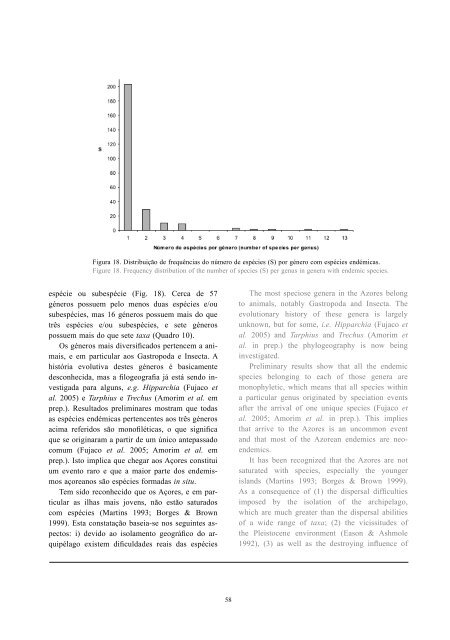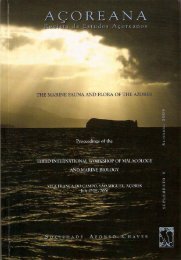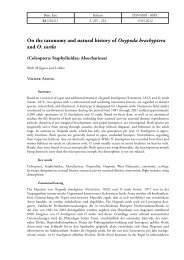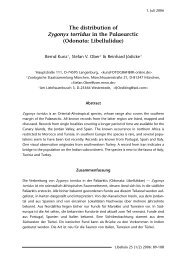(eds.) (2005). - Portal da Biodiversidade dos Açores - Universidade ...
(eds.) (2005). - Portal da Biodiversidade dos Açores - Universidade ...
(eds.) (2005). - Portal da Biodiversidade dos Açores - Universidade ...
You also want an ePaper? Increase the reach of your titles
YUMPU automatically turns print PDFs into web optimized ePapers that Google loves.
Figura 18. Distribuição de frequências do número de espécies (S) por género com espécies endémicas.<br />
Figure 18. Frequency distribution of the number of species (S) per genus in genera with endemic species.<br />
espécie ou subespécie (Fig. 18). Cerca de 57<br />
géneros possuem pelo menos duas espécies e/ou<br />
subespécies, mas 16 géneros possuem mais do que<br />
três espécies e/ou subespécies, e sete géneros<br />
possuem mais do que sete taxa (Quadro 10).<br />
Os géneros mais diversifica<strong>dos</strong> pertencem a animais,<br />
e em particular aos Gastropo<strong>da</strong> e Insecta. A<br />
história evolutiva destes géneros é basicamente<br />
desconheci<strong>da</strong>, mas a filogeografia já está sendo investiga<strong>da</strong><br />
para alguns, e.g. Hipparchia (Fujaco et<br />
al. <strong>2005</strong>) e Tarphius e Trechus (Amorim et al. em<br />
prep.). Resulta<strong>dos</strong> preliminares mostram que to<strong>da</strong>s<br />
as espécies endémicas pertencentes aos três géneros<br />
acima referi<strong>dos</strong> são monofiléticas, o que significa<br />
que se originaram a partir de um único antepassado<br />
comum (Fujaco et al. <strong>2005</strong>; Amorim et al. em<br />
prep.). Isto implica que chegar aos <strong>Açores</strong> constitui<br />
um evento raro e que a maior parte <strong>dos</strong> endemismos<br />
açoreanos são espécies forma<strong>da</strong>s in situ.<br />
Tem sido reconhecido que os <strong>Açores</strong>, e em particular<br />
as ilhas mais jovens, não estão satura<strong>dos</strong><br />
com espécies (Martins 1993; Borges & Brown<br />
1999). Esta constatação baseia-se nos seguintes aspectos:<br />
i) devido ao isolamento geográfico do arquipélago<br />
existem dificul<strong>da</strong>des reais <strong>da</strong>s espécies<br />
58<br />
The most speciose genera in the Azores belong<br />
to animals, notably Gastropo<strong>da</strong> and Insecta. The<br />
evolutionary history of these genera is largely<br />
unknown, but for some, i.e. Hipparchia (Fujaco et<br />
al. <strong>2005</strong>) and Tarphius and Trechus (Amorim et<br />
al. in prep.) the phylogeography is now being<br />
investigated.<br />
Preliminary results show that all the endemic<br />
species belonging to each of those genera are<br />
monophyletic, which means that all species within<br />
a particular genus originated by speciation events<br />
after the arrival of one unique species (Fujaco et<br />
al. <strong>2005</strong>; Amorim et al. in prep.). This implies<br />
that arrive to the Azores is an uncommon event<br />
and that most of the Azorean endemics are neoendemics.<br />
It has been recognized that the Azores are not<br />
saturated with species, especially the younger<br />
islands (Martins 1993; Borges & Brown 1999).<br />
As a consequence of (1) the dispersal difficulties<br />
imposed by the isolation of the archipelago,<br />
which are much greater than the dispersal abilities<br />
of a wide range of taxa; (2) the vicissitudes of<br />
the Pleistocene environment (Eason & Ashmole<br />
1992), (3) as well as the destroying influence of

















